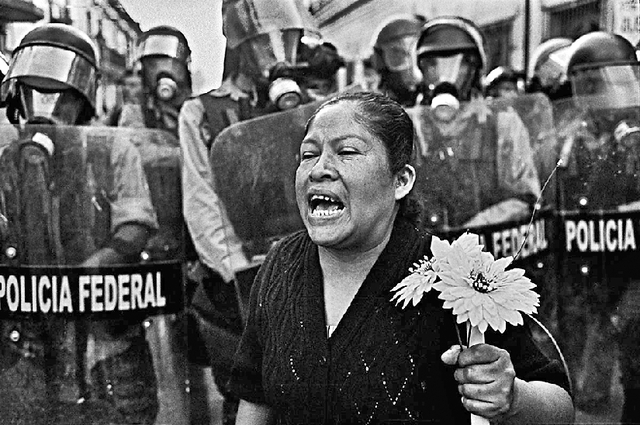It’s always a little embarrassing to be a tourist, camera hanging from your neck as you hurriedly check sites off your list, getting glimpses of only the things visitors are supposed to see. Looking back through the vacation photos, it’s like you were fooled a little, as though a palm tree-print curtain was pulled across the less pleasant aspects of the city, leaving only the cliché of G-rated sunsets and tourist-ready beaches. Photography students at Santa Fe Community College traveled to Oaxaca, Mexico, in the summers of 2005 and 2006, and made their way through ruins, markets, churches and museums. The beautiful color photos from these voyages make up one half of the exhibit, Oaxaca: Beauty in Turmoil . The students’ photos are gorgeous. A man dozes near bright bolts of cloth in Gretchen Scott’s “Napping with Color.” Susan Page’s “Karen” gives us a close-up of a woman smiling gently, the detail so crisp you can make out the perfect eyeliner along her lids, her small diamond earrings. The skill involved in the composition and printing of these beauties distance them from your standard “how I spent my summer vacation” snapshots. The only photograph to hint to the coming brutality, the thousand-man marches, the months-long protest, the arrests and abuses by the state of Oaxaca and Mexico’s federal government, is an image called “Down Time Between Protests,” a man in his car, eyes closed, a folded newspaper held loose in one hand. The visiting photographers also shot the early marches, the beginning of the unrest in early May 2006, when Oaxacan teachers took to the zocalo , the city’s center, to strike, demanding higher pay and better services for their students. Those photos are not in the show. Instead, photojournalist Antonio Turok’s black-and-white images pull back the curtain and show us the rest.In the Turok set, a bus burns in the night, one man stands on another’s back to graffiti a wall, battle lines are drawn and a confused-looking bystander, barefoot, crosses in front of barricades. In the next image, the barricade erupts into chaos, gas pouring in, people running. Turok documents Mexico’s federal police marching in the plaza, and, later, thousands take to a street packed with people as far as the camera’s lens can see. His images are not a complete documentation of the events, but they are enough to create a divide. Once you’ve made your way through the Turok photos, it’s hard to go back through the others without feeling as though, to some extent, you’d been fooled.Two Oaxacas: One full of brilliant color and lazy summers, one that keeps the tourist destination’s economy moving, one that became so profitable in its loveliness the cost of living went up, though workers’ wages did not. The other view is what was lurking underneath that pretty city: economic disparity, a feeling of helplessness as corruption ruled the government until the veneer split and social unrest shot to the surface. The first Oaxaca is gone. The booming tourist trade ground to a halt. The revolutionary Oaxaca is still in progress. A third Oaxaca has yet to be seen. What do those streets look like after thousands of marchers made their way through them? Where is the girl with the diamond earrings? Did she stay there? What have the merchants done in the meantime?Dreamy photos with heightened colors line one wall. Restless black-and-whites hang on the other. The physical space between them is only a few feet, and though they are the same place, they are worlds apart.
Oaxaca: Beauty in Turmoil runs through March 12 at camera hanging from your n (6401 Richards). The exhibit is free. 9 a.m. to 10 p.m. Monday through Friday or 9 a.m. to 8 p.m. on Saturdays. (505) 428-1230.










